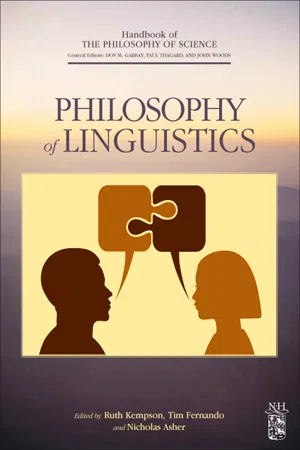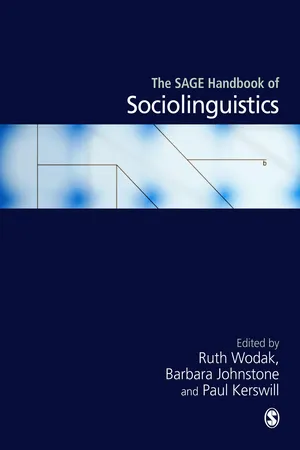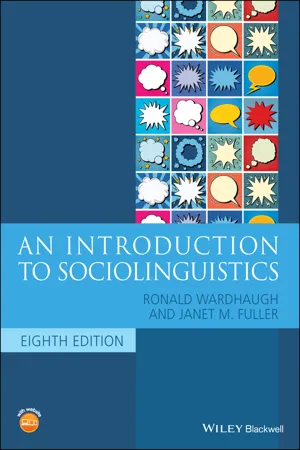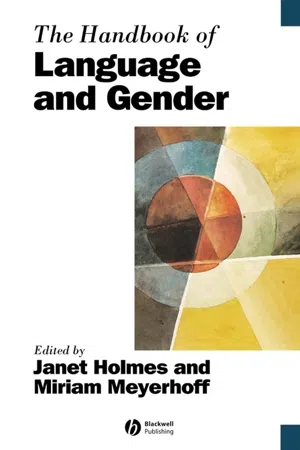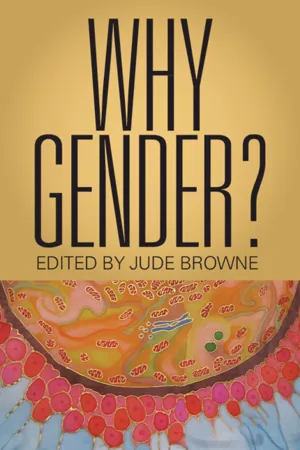Languages & Linguistics
Language and Gender
Language and gender refers to the study of how language and communication are influenced by gender differences. It explores how language can reflect and perpetuate gender stereotypes and power dynamics. This field examines various aspects of language, including vocabulary, grammar, and discourse, to understand how gender identity is constructed and maintained through linguistic practices.
Written by Perlego with AI-assistance
Related key terms
1 of 5
7 Key excerpts on "Language and Gender"
- eBook - ePub
- Dov M. Gabbay, Paul Thagard, John Woods(Authors)
- 2012(Publication Date)
- North Holland(Publisher)
How are gendered and sexualized individual and social identities constructed and changed? How are biology and social life intertwined in these processes? What kinds of diversity do we find among those who claim or are ascribed the same gender or the same sexual orientation? How do gender and sexuality interact with class, race, religion, economic status, age, nationality, and other dimensions of social difference? How do they enter into social and power relations? How do they relate to cultural ideologies and values, to default assumptions about ourselves and others? What moral issues are raised? Such questions are central to gender studies. Their answers involve many complex factors far beyond the realm of linguistics, but there are nearly always also significant matters of language and its use involved.Gender studies raises many challenging questions about language and about linguistic inquiry.• Which identities does language index and how? • Where do linguistic diversity and language change fit in a model of language as part of universal human biological endowment? • How well can speech acts be understood in individualistic terms? • How can available linguistic resources affect individual cognition and joint social pursuits? • How are linguistic forms invested with semantic content? With other kinds of communicative significance? • How and why do substantive conflicts of interest sometimes play out as 'mere' disputes over meaning?While not organized around these questions, this chapter explores some of the research on language, gender, and sexuality that have stimulated my own thinking about them.1 Indexing Identities
When linguists first began thinking about gender issues in the early 1970s, the focus was on what was then called women's studies. Linguists began exploring two main topics. One was so-called ‘women's language’ — ways of speaking supposed to be distinctively ‘feminine’, patterns that indicated or INDEXED identity as a woman. The other was ways of speaking about women — e.g., what were described as ‘euphemisms’ like lady and ‘dysphemisms’ like broad. American linguist Robin Lakoff [1975] offered this division into speaking by and speaking of and made a number of impressionistic claims that others sought to test more systematically.1 - eBook - PDF
- A. Ferrebe, F. Tolan, A. Ferrebe, F. Tolan(Authors)
- 2012(Publication Date)
- Palgrave Macmillan(Publisher)
7 Teaching Gender and Language Jane Sunderland The gender and language field Although sociolinguistic and other work had been done on Language and Gender at various points in the twentieth century (for example, Jespersen 1922; Labov 1972; Trudgill 1972), ‘Gender and Language’ as a field really came into being with the second wave of the ‘Western’ women’s movement (the ‘women’s liberation movement’), in the very late 1960s and early 1970s. Language was seen as one of the many ways (most) women were oppressed by (most) men. Early foci were ‘sexist language’ and ways in which men dominated women in private conversational talk. While there was much concern about gender representation – for example, in newspapers and children’s books – linguistic studies of these had yet to be done. Since then, the curricular content of Gender and Language Studies has expanded and developed apace, as has the scholarly reputation of the field. It is taught with increasing prevalence at undergraduate and postgraduate levels in universities across the world, 1 both as a unit of a module (or several units) and as a module in its own right (usually, but not always, an ‘option choice’). It forms part of different degree programmes and accordingly is taught in different departments, not only those with linguistics, English language and/or communication in their titles, but also Gender Studies, Women’s Studies and anthro- pology. To my knowledge, there is currently no ‘MA in Language and Gender’ programme anywhere in the world, but there is, I believe, no intellectual or epistemological obstacle to this. Indeed, there exists a vast body of literature on the topic, including monographs as well 102 - eBook - PDF
- Ruth Wodak, Barbara Johnstone, Paul E Kerswill, Ruth Wodak, Barbara Johnstone, Paul E Kerswill(Authors)
- 2010(Publication Date)
- SAGE Publications Ltd(Publisher)
Gender and Interaction T h e o d o s s i a -S o u l a P a v l i d o u 28 28.1 INTRODUCTION Research on Language and Gender has now been carried out for almost 40 years, and has produced a huge body of literature, including some out-standing introductions to the subject (e.g. Eckert and McConnell-Ginet, 2003), a handbook on this topic (Holmes and Meyerhoff, 2003) and even a journal ( Gender and Language ), launched in 2007. Over time, several changes have taken place in the kinds of questions that have been raised, the methods that have been employed and the types of explanations that have been sought. Such a development is not unique to this particular field of inquiry; rather, it goes hand in hand with and reflects shifts in paradigms within linguistics and women’s/gender studies, as well as in the ways in which ‘gender’ and ‘interaction’ are conceptualized. ‘Gender’ has been a familiar notion in the study of language – in contrast to other scientific fields – albeit with varying senses. Dating back to the fifth century BC , ‘grammatical gender’ in Indo-European languages has been associated with ‘natural gender’, i.e. the sex of animate beings denoted by those words. The contact of Europeans with languages and cultures in colo-nized countries, from the seventeenth century onwards, as well as later ethnographic work, gave rise to reports about ‘women’s languages’: language varieties that diverged from the ‘norm’ (i.e. men’s speech) and which were used exclusively or preferentially by women (see, for example, Bodine, 1975; Glück, 1979). In modern linguistics, it was sociolinguistics – in its varia-tionist version (e.g. Labov, 1972) – that introduced ‘sex’ as an independent variable which, along with class, age and style, is correlated with the mani-festation of specific linguistic variables to describe variation and explain change in language (see, for example, Wodak and Benke, 1997). - eBook - PDF
- Ronald Wardhaugh, Janet M. Fuller(Authors)
- 2021(Publication Date)
- Wiley-Blackwell(Publisher)
Sociolinguistics and Social Justice Part IV An Introduction to Sociolinguistics, Eighth Edition. Ronald Wardhaugh and Janet M. Fuller. © 2021 John Wiley & Sons Ltd. Published 2021 by John Wiley & Sons Ltd. Companion website: www.wiley.com/go/wardhaugh8e 11 A major topic in sociolinguistics has been the connection between linguistic features – the structures, vocabularies, and ways of using particular languages – and the gender and sexu- ality identities and expressions of the people who use these languages. While initially the research question was, ‘Do men and women speak differently?’, we have moved away from questions rooted in essentialist understandings of social categories to ask ‘How is language part of gender and sexuality identities and ideologies?’ Defining Terms: Sex Category, Gender, and Sexuality Before discussing how language, gender, and sexuality are dealt with in sociolinguistics, we need to define some concepts we will use in our discussion: sex category, gender, and sexu- ality. Sex categories are based on the biological distinction between ‘male’ and ‘female.’ Such static and binary categories are increasingly challenged, both in contemporary cul- tural movements and in scholarship about gender and sexuality. One area of research on the English language which reflects this is studies on singular they, especially when used as a non-binary pronoun (e.g., Bradley 2020; Bradley et al. 2019). Much more prevalent is a long-standing body of research on gender nonconforming and non-binary identities in many cultures around the world (e.g., Bing and Bergvall 1996; Hall 2002; Hall and O’Donovan 1996; Webster 2019; Richards et al. 2016; Zimman 2018). The idea that there are more than two sexes is not new and is a very Western notion. This view has influenced research in this area, which often portrays non-binary or trans identi- ties as a new development, but this is an ethnocentric viewpoint. - eBook - PDF
- Prof. Nancy H. Hornberger, Dr. Sandra Lee McKay, Nancy H. Hornberger, Sandra Lee McKay(Authors)
- 2010(Publication Date)
- Multilingual Matters(Publisher)
From this view, gender is not a characteristic of a person but a performance enacted in daily life that involves an ongoing negotiation between self and society. Through ways of speaking and acting, individuals perform gendered identities that may in turn challenge, comply with or even subvert domi-nant ideologies of gender. In performing their gendered selves, individu-als make choices as to how to style themselves, though most scholars would also agree that these choices are not isolated from societal expecta-tions, cultural models and ideologies about gender. For this reason, gender is best understood as ‘a complex system of social relations and discursive practices, differentially constructed in local contexts’ (Norton & Pavlenko, 2004: 504). Of course, some researchers still treat gender as a dependent variable in research, but this is the result of the researchers’ underlying ontological positions that do not distinguish between sex and gender. As Davis and Skilton-Sylvester (2004: 384–385) explain, ‘SLA scholars who adhere to a positivist or postpositivist research tradition that values the search for reality (or an approximation of reality) and the belief that find-ings can be generalized may reject constructivist, critical-feminist, and poststructuralist research paradigms as unscientific’. In contrast, research that examines gender as a complex system of social relations does not seek to make generalizations about gendered experiences, nor does it strive to predict how individuals may experience language learning based on other individuals’ experiences. Methods for Studying Gender In recent years, the methods used to investigate gendered performances and gendered experience among L1 and L2 language users have mostly employed various approaches to discourse analysis, narrative inquiry and ethnography. - eBook - PDF
- Janet Holmes, Miriam Meyerhoff, Janet Holmes, Miriam Meyerhoff(Authors)
- 2008(Publication Date)
- Wiley-Blackwell(Publisher)
We also need to consider how certain basic categories of analysis found in other disciplines are implemented in our own. I argue here that the fundamental feminist category of “gender,” as implemented in sociolinguistics, has often included certain political and social assumptions which prematurely narrow our area of inquiry. Early sociolinguistic studies of gender often assumed that gender should be studied where it was most salient, and that gender was most salient “in cross-sex interaction between potentially sexually accessible interlocutors, or same-sex interaction in gender-specific tasks” (Brown and Levinson 1983: 53). At its best, work based on this assumption led to a series of insightful studies of the linguistic styles of men and women in romantic heterosexual relation-ships or in experimental settings designed to simulate such relationships (e.g. Fishman 1983; Gleason 1987; Tannen 1990; West and Zimmerman 1983). There are, however, at least four significant, and increasingly controversial, theo-retical assumptions about gender embedded in this recommendation: (1) gender is closely wedded to sex, and the study of gender is closely wedded to the study of heterosexuality; (2) gender is an attribute; (3) the study of gender is the study of individuals; and (4) gender is best studied where most salient. In this chapter I explore each of these in turn. In this discussion, as elsewhere, theories about gender always have more than theoretical sig-nificance; they always suggest the cause of inequities and thus indicate where society should direct its resources to redress inequity (see Jaggar 1983). Deciding amongst different theories of gender is thus no mere theoretical exercise; it is directly linked to deciding upon political strategies for feminist activism. 1.1 The relationship of gender to sex and sexuality The distinction between sex and gender has been one of the foundations of Western feminist thought. - No longer available |Learn more
- Jude Browne(Author)
- 2021(Publication Date)
- Cambridge University Press(Publisher)
1 GENDER IN TRANSLATION: BEYOND MONOLINGUALISM 17 RESISTANCE TO GENDER, RESISTANCE TO TRANSLATION Let me foreground two points that will prove central to my argu- ment. The first is that sex cannot be fully separated from the linguistic formulation that establishes it as a fact. The linguistic formulation of sex as a fact is, in my view, part of what is meant by gender. Second, gender is a foreign word. Gender always produces a problem for translators. Indeed, gender only arrives in any language as a result of a difficult translation. As a result, it never quite carries the same meaning in different languages. In effect, my thesis is that translation is the condition of the possibility of gender theory in a global frame. The resistance may be to the tasks of translation that emerge for global conversation and scholarship on the part of Anglophone cultural imperialists who do assume the universality of all that is thought within English (as both Sandra G. Harding and Jack Halberstam argue in different ways in this volume) but it may also be the result of a fierce defense of patri- archal power, the heteronormative family, the natural character of both sexual difference and hierarchy, and the pathology of LGBTIQ lives. Sometimes the resistance to the term “gender” is syntactical, as if to start to use the term in language would challenge, or even defy, the basic syntactical structures that govern sense-making within a given language. This produces a different kind of linguis- tic disturbance at a basic level. At first the problem appears to be one of usage: How does one use the term? Does a person belong to a gender? Is gender a predicate of a person? How does one use the term “gender” in a sentence? Other times, the problem seems to be the introduction of a broader set of cultural practices where the use of the term is presupposed and put into play.
Index pages curate the most relevant extracts from our library of academic textbooks. They’ve been created using an in-house natural language model (NLM), each adding context and meaning to key research topics.
